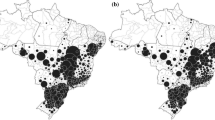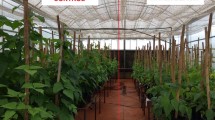Abstract
Temperature stress including low and high temperature adversely affect the growth, development and productivity of crops. Faba bean (Vicia faba L.) is an important crop as both human food source and animal feed, which contains a range of varieties that are sensitive to cold and heat stresses. In this study, 127 faba bean genotypes were collected from gene banks based on differences in geographical origin. The 127 genotypes were treated by single cold stress (2/2 °C day/night temperature (DT/NT)) and 42 genotypes were treated by either single episode of cold or heat (38/30 °C DT/NT) stress, or a combination of both at photosynthetic photon flux density of 250 µmol m−2 s−1. Chlorophyll fluorescence was used to detect the tolerance of faba beans to low and high temperatures. The maximum quantum efficiency of photosystem II (PSII), Fv/Fm, revealed pronounced differences in cold tolerance among the faba bean genotypes. The 42 genotypes were clustered into four groups according to cold and heat stresses, respectively, and the susceptibilities of faba beans under temperature stress could be distinguished. The combination of cold and heat stresses could aggravate the damage on reproductive organs, but not on the leaves, as indicated by the Fv/Fm. These results confirm that the use of Fv/Fm is a useful approach for detecting low and high temperature damage to photosystem II and to identify tolerant faba bean genotypes, however the results also indicate that the geographical origin of the genotypes could not directly be used to predict climate resilience. These sources of cold- and heat-tolerance could improve the temperature tolerance of faba bean in breeding programs.





Similar content being viewed by others
References
Arbaoui M, Link W (2008) Effect of hardening on frost tolerance and fatty acid composition of leaves and stems of a set of faba bean (Vicia faba L.) genotypes. Euphytica 162:211–219
Baker NR (2008) Chlorophyll fluorescence: a probe of photosynthesis in vivo. Annu Rev Plant Biol 59:89–113
Baker NR, Rosenqvist E (2004) Applications of chlorophyll fluorescence can improve crop production strategies: an examination of future possibilities. J Exp Bot 55:1607–1621
Berry J, Björkman O (1980) Photosynthetic response and adaptation to temperature in higher plants. Annu Rev Plant Physiol 31:491–543
Branca G, Lipper L, McCarthy N, Jolejole MC (2013) Food security, climate change and sustainable management. A review. Agron Sustain Dev 33:635–650
Čajánek M, Štroch M, Lachetová I, Kalina J, Spunda V (1998) Characterization of the photosystem II inactivation of heat-stressed barley leaves as monitored by the various parameters of chlorophyll a fluorescence and delayed fluorescence. J Photochem Photobiol B 47:39–45
Cao X, Jiang F, Wang X, Yang Z, Wu Z (2015) Comprehensive evaluation and screening for chilling-tolerance in tomato lines at the seedling stage. Euphytica 205:569–584
Crépon K, Marget P, Peyronnet C, Carrouée B, Arese P, Duc G (2010) Nutritional value of faba bean (Vicia faba L.) seeds for feed and food. Field Crops Res 115:329–339
Duc G (1997) Broad bean (Vicia faba L.). Field Crop Res 53:99–109
Guy S, Berger M, Planchon C (1997) Response to low temperature in dinitrogen fixing soybeans. Plant Sci 123:67–75
Heidarvand L, Amiri RM (2010) What happens in plant molecular responses to cold stress? Acta Physiol Plant 32:419–431
Herzog H (1987) A quantitative method to assess freezing resistance in faba beans. J Agron Crop Sci 158:195–204
Herzog H, Olszewski A (1998) A rapid method for measuring freezing resistance in crop plants. J Agron Crop Sci 181:71–79
Hetherington SE, He J, Smillie RM (1989) Photoinhibition at low temperature in chilling-sensitive and -resistant plants. Plant Physiol 90:1609–1615
Inci NE, Toker C (2011) Screening and selection of faba beans (Vicia faba L.) for cold tolerance and comparison to wild relatives. Genet Resour Crop Evol 58:1169–1175
Kościelniak J, Biesaga-Kościelniak J (2006) Photosynthesis and non-photochemical excitation quenching components of chlorophyll excitation in maize and field bean during chilling at different photon flux density. Photosynthetica 44:174–180
Kurukulasuriya P, Rosenthal S (2013). Climate change and agriculture: a review of impacts and adaptations. https://openknowledge.worldbank.org/handle/10986/16616. License: CC BY 3.0 IGO
Link W, Balko C, Stoddard FL (2010) Winter hardiness in faba bean: physiology and breeding. Field Crop Res 115:287–296
López-Bellido FJ, López-Bellido L, López-Bellido RJ (2005) Competition, growth and yield of faba bean (Vicia faba L.). Eur J Agron 23:359–378
Loss SP, Siddique KHM (1997) Adaptation of faba bean (Vicia faba L.) to dryland mediterranean-type environments I. Seed yield and yield components. Field Crop Res 52:17–28
Maqbool A, Shafiq S, Lake L (2010) Radiant frost tolerance in pulse crops—a review. Euphytica 172:1–12
Martin B, Ort DR (1985) The recovery of photosynthesis in tomato subsequent to chilling exposure. Photosynth Res 6:121–132
Mathur S, Jajoo A, Mehta P, Bharti S (2011) Analysis of elevated temperature-induced inhibition of photosystem II using chlorophyll a fluorescence induction kinetics in wheat leaves (Triticum aestivum). Plant Biol 13:1–6
Mittler R (2006) Abiotic stress, the field environment and stress combination. Trends Plant Sci 11:15–19
Mittler R, Finka A, Goloubinoff P (2012) How do plants feel the heat? Trends Biochem Sci 37:118–125
Morales D, Rodríguez P, Dell’amico J, Nicolás J, Torrecillas E, Sánchez-Blanco A (2003) High-temperature preconditioning and thermal shock imposition affects water relations, gas exchange and root hydraulic conductivity in tomato. Biol Plant 47:203–208
Murray GA, Eser D, Gusta LV, Eteve G (1988) Winter hardiness in pea, lentil, faba bean and chickpea. In: Summerfield RJ (ed) World crops: cool season food legumes: Proceedings of the International Food Legume Research Conference, Lentil, Faba bean and Chickpea, Spokane, pp 831–843
Ortiz R, Sayre KD, Govaerts B, Gupta R, Subbarao GV, Ban T, Hodson D, Dixon JM, Ortiz-Monasterio I, Reynolds M (2008) Climate change: can wheat beat the heat? Agric Ecosyst Environ 126:46–58
Rachmilevitch S, DaCosta M, Huang B (2006) Physiological and biochemical indicators for stress tolerance. In: Huang B (ed) Plant-environment interactions. Taylor and Francis, Boca Raton, pp 321–355
Sánchez B, Rasmussen A, Porter JR (2014) Temperatures and the growth and development of maize and rice: a review. Glob Change Biol 20:408–417
Serraj R, Bidinger FR, Chauhan YS, Seetharama N, Nigam SN, Saxena NP (2003) Management of drought in ICRISAT cereal and legume mandate crops. In: Kijne JW, Barker R, Molden D (eds) Water productivity in agriculture: Limits and opportunities for improvement. CABI Publishing, Wallingford, pp 127–144
Sharma DK, Andersen SB, Ottosen CO, Rosenqvist E (2012) Phenotyping of wheat cultivars for heat tolerance using chlorophyll a fluorescence. Funct Plant Biol 39:936–947
Siddiqui MH, Al-Khaishany MY, Al-Qutami MA, Al-Whaibi MH, Grover A, Ali HM, Al-Wahibi MS (2015) Morphological and physiological characterization of different genotypes of faba bean under heat stress. Saudi J Biol Sci 22:656–663
Sinsawat V, Leipner J, Stamp P, Fracheboud Y (2004) Effect of heat stress on the photosynthetic apparatus in maize (Zea mays L.) grown at control or high temperature. Environ Exp Bot 52:123–129
Skrudlik G, Baczek-Kwinta R, Koscielniak J (2000) The effect of short warm breaks during chilling on photosynthesis and the activity of antioxidant enzymes in plants sensitive to chilling. J Agron Crop Sci 184:233–240
Srinivasan A, Takeda H, Senboku T (1996) Heat tolerance in food legumes as evaluated by cell membrane thermostability and chlorophyll fluorescence techniques. Euphytica 88:35–45
Stoddard FL, Balko C, Erskine W, Khan HR, Link W, Sarker A (2006) Screening techniques and sources of resistance to abiotic stresses in cool-season food legumes. Euphytica 147:167–186
Wang X, Cai J, Liu F, Dai T, Cao W, Wollenweber B, Jiang D (2014) Multiple heat priming enhances thermo-tolerance to a later high temperature stress via improving sub cellular antioxidant activities in wheat seedlings. Plant Physiol Biochem 74:185–192
Zhou R, Yu X, Kjær KH, Rosenqvist E, Ottosen CO, Wu Z (2015) Screening and validation of tomato genotypes under heat stress using Fv/Fm to reveal the physiological mechanism of heat tolerance. Environ Exp Bot 118:1–11
Acknowledgements
The authors thank Ms. Ruth Nielsen, Ms. Helle Kjaersgaard and Mr. Kaj Ole Dideriksen for their assistance during the experiments. We also acknowledge the funding from the GLUD Foundation, Denmark and ERDF EU project GreenGrowing. Congratulations to Ruth. Have a nice long holiday.
Author information
Authors and Affiliations
Corresponding authors
Electronic supplementary material
Below is the link to the electronic supplementary material.
Rights and permissions
About this article
Cite this article
Zhou, R., Hyldgaard, B., Yu, X. et al. Phenotyping of faba beans (Vicia faba L.) under cold and heat stresses using chlorophyll fluorescence. Euphytica 214, 68 (2018). https://doi.org/10.1007/s10681-018-2154-y
Received:
Accepted:
Published:
DOI: https://doi.org/10.1007/s10681-018-2154-y




